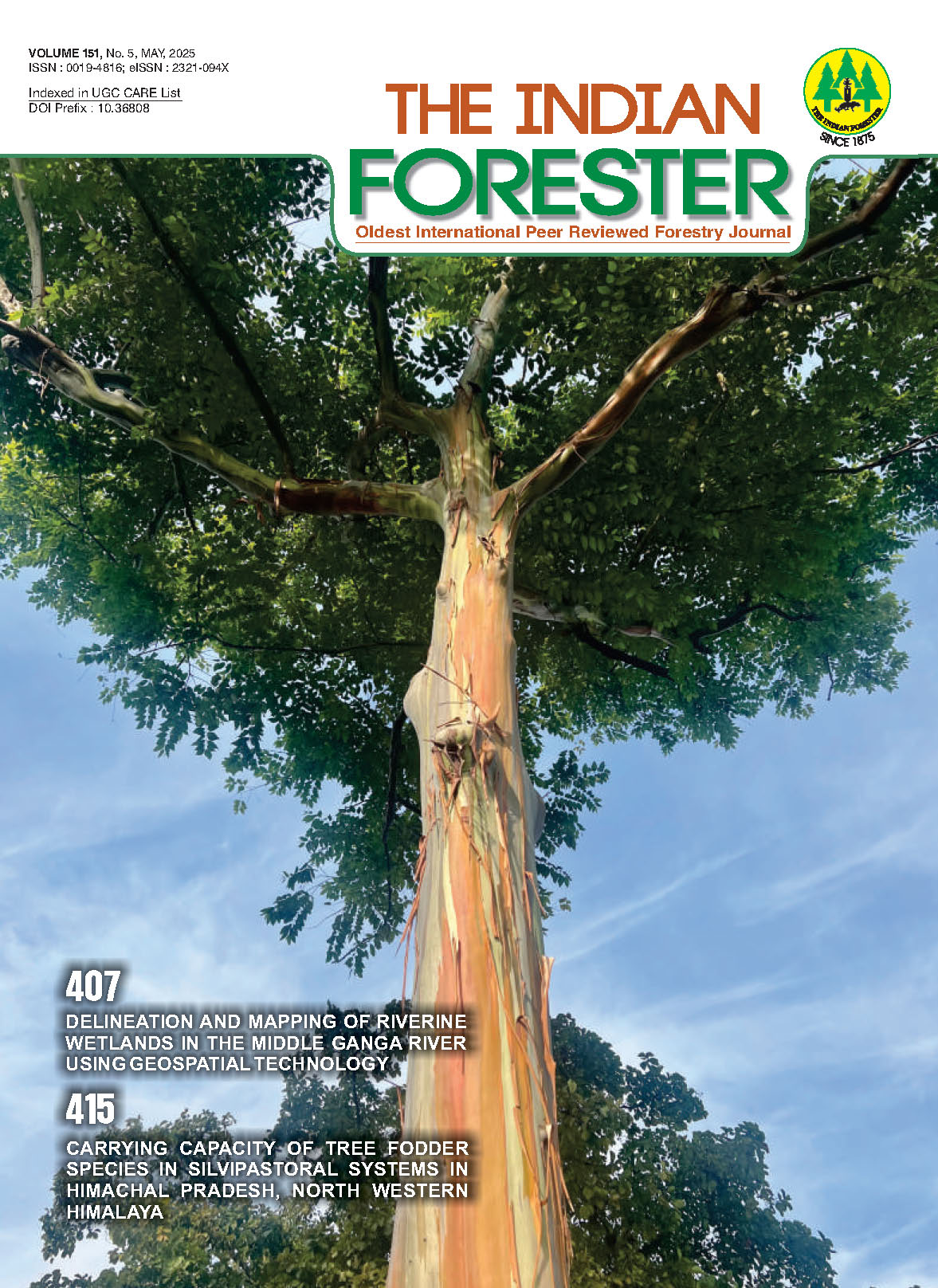Conservation status of Birds in Chhilchhila Wildlife Sanctuary: A Protected bird area in Haryana, India
DOI:
https://doi.org/10.36808/if/2025/v151i5/170682Keywords:
Bird Sanctuary, Line Transects, Migratory Birds, Species CompositionAbstract
Chhilchhila Wildlife Sanctuary harbors a diverse range of bird species, playing critical role in regional biodiversity conservation. Systematic bird surveys were carried out using line transects and opportunistic encounter methods across various habitats from April 2022-March 2023. A total of 133 species, belonging to 17 orders, 49 families and 103 genera were recorded, among which 80 were residents, 45 were winter migrants and 8 were summer migrants. Among the reported species, one species was Vulnerable (Common Pochard Aythya ferina) and five species were classified as Near-Threatened (Oriental Darter Anhinga melanogaster, Alexandrine Parakeet Palaeornis eupatria, Black-headed Ibis Threskiornis melanocephalus, Woolly-necked Stork Ciconia episcopus, Painted Stork Mycteria leucocephala) as per IUCN (2023); and eight species are included in Schedule-I of IWPA (1972). These findings shows that the Sanctuary acts as a potential habitat for globally threatened species and that appropriate conservation approaches should be implemented to protect these species.
References
Baral H.S. and Inskipp C. (2005). Important Bird Areas in Nepal: Key Sites for Conservation. Bird Conservation Nepal and Birdlife International, pp 242.
Byju H., Raveendran N., Ravichandran S. and Kishore R. (2023). An annotated checklist of the avifauna of Karangadu mangrove forest, Ramanathapuram, Tamil Nadu, with notes on the site's importance for waterbird conservation. Journal of Threatened Taxa, 15(3): 22813–22822. https://doi.org/ 10.11609/jott.8356.15.3.22813-22822 DOI: https://doi.org/10.11609/jott.8356.15.3.22813-22822
Devanda M., Jayashankar M. and Shantabala Devi G. (2023). Avifaunal diversity of Pakke Tiger Reserve in the Eastern Himalaya hotspot of Arunachal Pradesh, India, Journal of Wildlife and Biodiversity, 7(4): 171-182. DOI: https://doi.org/10.5281/zenodo.8286688.
Grimmett R., Inskipp C. and Inskipp T. (2015). Birds of Indian Subcontinent.2nd Edition. Oxford University Press, India.
IUCN (2023). The IUCN Red List of Threatened Species. Version 2023-1. Available: https://www.iucnredlist.org. (Accessed: April 1, 2024).
IWPA (1972). Indian Wildlife Protected Act. Available: http://www.wiienvis.nic.in/Database/Schedule Species Database_7969.aspx (Accessed: May 1, 2024).
Joshi A.K. (2023). Seasonal diversity and dietary guild structure of birds in two Vindhyan gorge forests of Rajasthan, India. Journal of Threatened Taxa, 15(2): 22597–22605. https://doi.org/10.11609/jott.7103.15.2.22597-22605 DOI: https://doi.org/10.11609/jott.7103.15.2.22597-22605
Kalsi R.S., Sharma S.C. and Choudhary J.R. (2019). Birds of Haryana – A Field Guide. Unique Publications, Haryana, India.
Kattan G.H. and Franco P. (2004). Bird diversity along elevational gradients in the Andes of Colombia: area and mass effects. Global Ecology and Biogeography, 13(5): 451–458. https://doi.org/10.1111/j.1466-822X.2004.00117.x DOI: https://doi.org/10.1111/j.1466-822X.2004.00117.x
Kumar P. and Sahu S. (2020). Composition, diversity and foraging guilds of avifauna in agricultural landscapes In Panipat, Haryana, India. Journal of Threatened Taxa, 12(1): 15140–15153. https://doi.org/10.11609/jott.5267.12.1.15140-15153 DOI: https://doi.org/10.11609/jott.5267.12.1.15140-15153
Kumar P. and Gupta S.K. (2013). Status of wetland birds of Chhilchhila Wildlife Sanctuary, Haryana, India. Journal of Threatened Taxa, 5(5): 3969–3976. https://doi.org/ 10.11609/JoTT.o3158.3969-76 DOI: https://doi.org/10.11609/JoTT.o3158.3969-76
Praveen J., Jayapal R. and Pittie A. (2018). Taxonomic Updates to the Checklist of birds of India and South Asian regions-2018, Indian Birds, 14(2): 37–42.
Rai D. and Vanita (2021). Community composition and status of avifaunal diversity in and around Ottu reservoir of Sirsa, Haryana, India. Journal of Applied and Natural Science, 13(2): 593–606. https://doi.org/10.31018/jans.v13i2.2666 DOI: https://doi.org/10.31018/jans.v13i2.2666
Sutherland W.J., Newton I. and Green R.E. (2005). Bird Ecology and Conservation: A handbook of Techniques. Oxford University Press, Oxford, United Kingdom.
Downloads
Downloads
Published
How to Cite
Issue
Section
License
Unless otherwise stated, copyright or similar rights in all materials presented on the site, including graphical images, are owned by Indian Forester.





